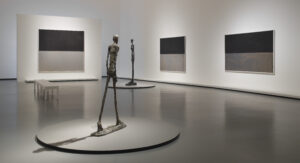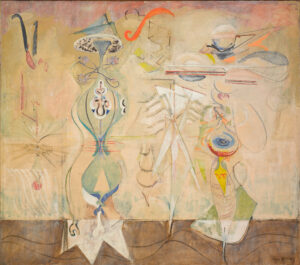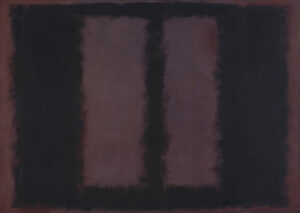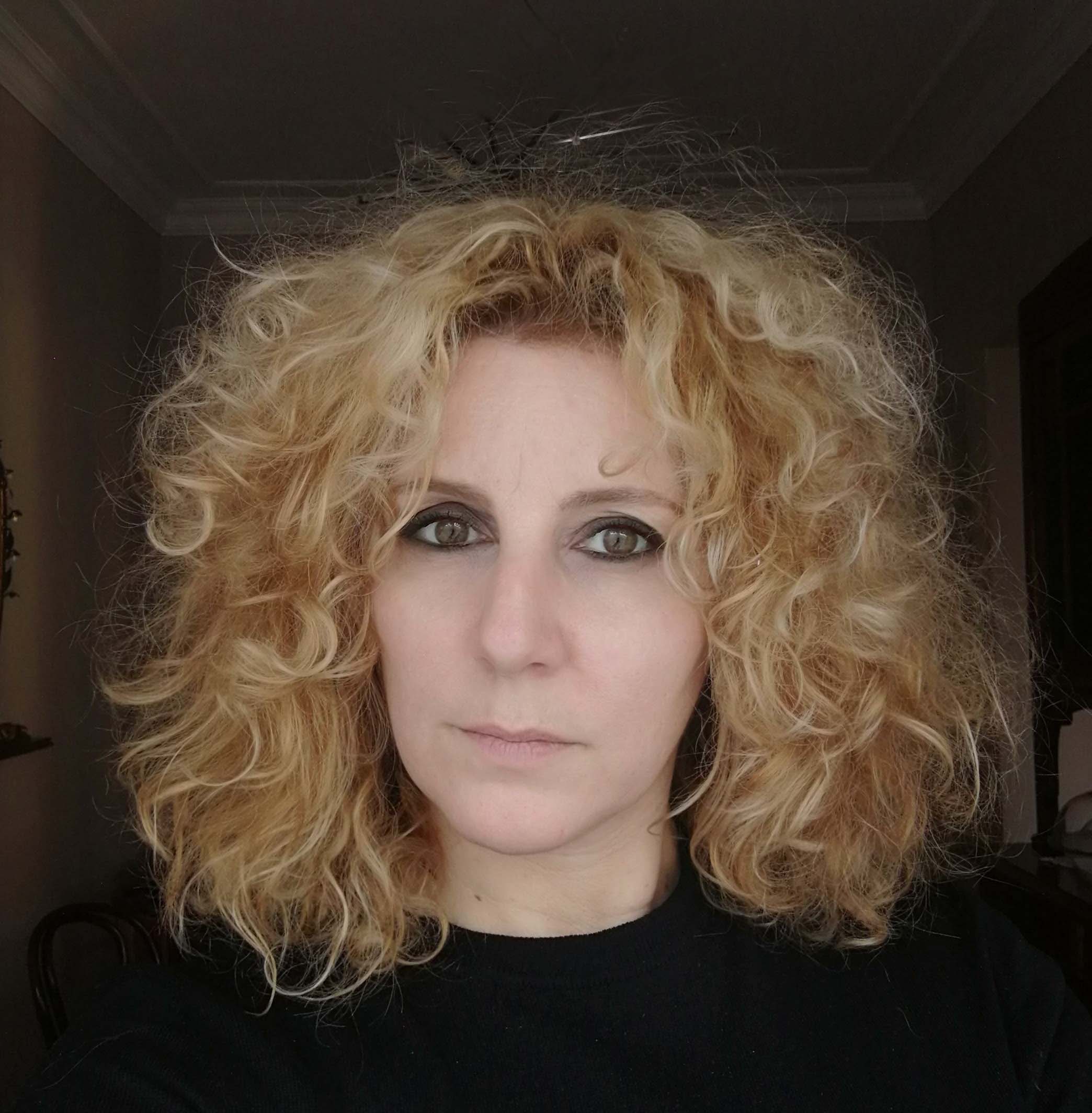Sometimes artists, during the process of creating, are inspired by intelligible intuition, while in other cases the paintings only represent what they seem. In the case of Mark Rothko’s works, no matter what era one examines them in, they always conceal a profound meaning, although the author has shied away from any hidden interpretation. «He simply wanted the viewer to look, to be present, in front of the work»: in this way his son Christopher, a psychologist and writer, describes Mark Rothko’s feelings about his father’s state of mind during the creative process.

Installation view of Mark Rothko’s exhibition, gallery 10, floor 2, Black and Gray room, Giacometti, from 10/18/2023 to 4/2/2024 Fondation Louis Vuitton, Paris © 1998 Kate Rothko Prizel & Christopher Rothko – Adagp , Paris, 2023
A long and fought artistic phase that is outlined in the round by the extraordinary exhibition curated by Suzanne Pagé, on show at the Fondation Louis Vuitton in Paris until 2 April 2024, with the minimalist title ‘Mark Rothko’. The artist’s works, which can be placed chronologically in the early phase of his career, are watercolors with elongated, muted and faded figures that were so reminiscent of Giacometti’s sculptures. The obvious marriage of the forms of the two artists is also emphasized in the exhibition by displaying Giacometti’s works, which Rothko himself had imagined as part of an installation he was to carry out for the new Paris pavilion of Unesco. The statues dialogue with the darkest and gloomiest paintings in the artist’s oeuvre, those that a cursory biographical reconstruction traces back to the darkest periods of Rothko’s life, but which, on closer inspection, also represent, apart from the painter’s conflicted and tumultuous state of mind at the time, the narrative evolution of the research he carried out from the beginning.

Mark Rothko, “Self Portrait”, 1936, oil on canvas, Christopher Rothko collection © 1998 Kate Rothko Prizel & Christopher Rothko – Adagp, Paris, 2023
All in all, Rothko was always a fighter and a protester, a man of lively intelligence demonstrated since his studies at Yale, capable of renouncing a pre-established career and seeking his own path. A tormented painter who did not hide and confronted the injustices of which he was a victim, making his voice heard. This is what happened when he decided to leave the trade union, of which he was an active member, to join the No Blackout Art movement, according to which the war against Nazism had to be fought by everyone, with a social obligation to fight for their freedom. It is inescapable at this stage to emphasize how the fact that he had been the son of Russian immigrants of Jewish origin, had always linked him to the Shoah and how all the reflections he may have carried out in that America, so apparently hospitable and full of possibilities for artists, even foreign ones, in reality stimulated resistance, not even too concealed, to the more ethereal pictorial currents that were far from his cultural references.

Mark Rothko, “Slow Swirl at the Edge of the Sea”, 1944, oil on canvas, Museum of Modern Art, New York, Bequest of Mrs. Mark Rothko through The Mark Rothko Foundation, Inc. © 1998 Kate Rothko Prizel & Christopher Rothko – Adagp, Paris, 2023
In this America that had allowed him to start his career by participating in the Federal Art Project that subsidized emerging artists in the midst of the New Deal, allowing them to experiment with their innovative art, anti-Semitism was rampant and to avoid being labeled as part of the Jewish culture that was disfavoured at the time, Mark Rothkovich decided to change his surname to Rothko, like many immigrants from his generation. The rebellion was therefore hindered by the desire for affirmation and the fact that he joined ‘The Irascibles’ in that memorable photo in which he appears with his gaze averted and sideways to the lens, looking sideways at the camera, denotes how marginal he felt in that group. In the first part of his artistic research, his pictorial references were to the surrealists such as Ernst, de Chirico, Miró, inspiring the “Subway Series”, a series of paintings that took their cue from the New York underground, outlining subtle figures and disturbing faces. The subsequent and physiological evolution, the result of historical change, the climate of values loss and the spread of war, made him join the Myth Makers, a pictorial current inspired by Greek myths and primitive culture, to which figures such as Pollock or Gottlieb also belonged. The reference to primitive painting, especially in the way colors are made, will remain Rothko’s signature throughout his career.

Mark Rothko, “Black On Maroon”, 1958, oil on canvas, Tate, London presented by the artist through American Foundation of Arts, 1969 © 1998 Kate Rothko Prizel & Christopher Rothko – Adagp, Paris, 2023
The use of dry pigments to which he mixed a large number of additives, some of which remain unknown to this day, the repainting of colors after the drying phase to give gloss and thickness to the texture, remains the artist’s characteristic modus operandi. In the latter part of his career, the “Multiforms,” paintings divided into two or three intense colors, sometimes interspersed with neutral colors, which break up the dominant nuance, total his works. The use of tone changes dramatically, veering from warm colors such as orange and red, to intense blue, black and a little white. Those who knew him intimately, such as his son Christopher, urge us to stay away from brainwashing interpretations concerning the way he painted and the inner dissension that the artist lived until the tragic climax of his suicide. Rothko’s sole purpose was to allow the viewer to go through an experience, which he himself felt when painting, communicating his state of mind through colors. Looking at his paintings, although equally influenced by what was his human and professional journey, one cannot help but admit that he fulfilled his intent.
Info:
Mark Rothko
18/10/2023 – 2/04/2024
Curatori: Suzanne Pagé et Christopher Rothko con François Michaud e
Ludovic Delalande, Claudia Buizza, Magdalena Gemra, Cordélia de Brosses.
Fondation Louis Vuitton Paris
www.fondationlouisvuitton.fr/en

Globetrotter, passionate about literature, lover of art and photography. I never leave for a trip without taking with me a book by an author of the place where I will go. I have dreamed of moving to Paris for years and sooner or later I will!






NO COMMENT